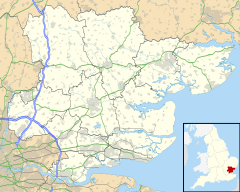Parkeston, Essex facts for kids
Quick facts for kids Parkeston |
|
|---|---|
| Area | 0.708 km2 (0.273 sq mi) |
| Population | 932 (2018 estimate) |
| • Density | 1,316/km2 (3,410/sq mi) |
| OS grid reference | TM236319 |
| Civil parish |
|
| District |
|
| Shire county | |
| Region | |
| Country | England |
| Sovereign state | United Kingdom |
| Post town | HARWICH |
| Postcode district | CO12 |
| Dialling code | 01255 |
| Police | Essex |
| Fire | Essex |
| Ambulance | East of England |
| EU Parliament | East of England |
| UK Parliament |
|
Parkeston is a port village in Essex, England. It's located on the south bank of the River Stour, about 1.6 kilometers (1 mile) from Harwich. In 2018, around 932 people lived in Parkeston. It's known for its important port, which connects England to other parts of Europe.
History of Parkeston
In the 1880s, a company called the Great Eastern Railway (GER) built a new port here. They used land that was once an island called Ray Island. This port was made for trains to bring goods for trade with Europe. It was named Parkeston Quay after Charles Henry Parkes, who was the head of the GER company.
Most of the houses in Parkeston were built for the railway workers. Some streets even have names linked to the ships that used the port, like Tyler Street, Hamilton Street, Adelaide Street, and Princess Street. These names came from old paddle steamers like The Lady Tyler and Princess of Wales.
Parkeston is sometimes called "Spike Island" or "Cinder City" by local people. "Cinder City" was a good name because a lot of the marshy land was filled in using waste materials from the railway.
It's quite special because not many villages were built by a railway company just to house its workers. This railway operation was very big. It included a place to fix trains and large workshops to repair the many ships that used the port. At its busiest, there were about a dozen ferries and cargo ships.
From the early 1900s, big passenger ferries started sailing from Parkeston. They mainly went to the Hook of Holland and later to Esbjerg in Denmark. During both the First and Second World Wars, Parkeston was an important naval base for the navy. Today, Parkeston Quay is called Harwich International Port. The railway station is now known as Harwich International. Across the Stour estuary, you can see the Port of Felixstowe, which is the UK's busiest container port.
Harwich Gateway Retail Park
Besides the port, a big shopping area called Harwich Gateway Retail Park has grown in Parkeston. It's located next to the port. The first shop there was a supermarket called Safeway, which opened in 1997. It's now a Morrisons store.
Later, more shops were built. A discount supermarket called Lidl opened, along with a Premier Inn hotel and a Brewers Fayre restaurant in 2004. More recently, a Home Bargains store opened in 2014. A small group of houses called "The Gateway" was also built nearby.
Even more recently, a McDonald's and a Costa have opened at the retail park. In 2022, a Greggs bakery also started serving customers there.
Parkeston Timeline
- 1883: Parkeston Quay officially opened. Charles H. Parkes, the head of the Great Eastern Railway Company, was there.
- 1914–1918: During World War I, the Royal Navy used Parkeston Quay as a base for its submarines. Some submarines sank after crashing outside the harbor, but many were saved.
- 1917: Scientists like Sir William Bragg and Sir Ernest Rutherford set up a research station at the Quay. They studied how to use sound waves (like ASDIC) and magnets to find submarines.
- 1918: After World War I, 113 German submarines surrendered to the Royal Navy Submarine Service at Parkeston Quay on November 20.
- 1939: During World War II, the navy took over Parkeston Quay again. It was known as HMS Badger until 1945.
- 1946: The quay was badly damaged by air raids during the Second World War.
- 1953: A ferry called the Duke of York crashed with an American cargo ship. Another Danish passenger ship, the Kronprins Frederik, caught fire while docked. Both ships were damaged. The village also had very bad flooding that year.
- 1964: The Carless oil refinery opened next to the port. This meant oil tankers also started using the port.
- 1974: A large ship called the St Edmund started service. It was later used by the UK Ministry of Defence as a troop ship during the Falklands War in 1982.
- 1983: The St Nicholas, which was the biggest superferry on the North Sea at the time, began service from Harwich.
- 1986: More than 2 million passengers traveled through the port in one year for the first time.
- 1989: The summer ferry service to Kristiansand, Norway, ended. This service had been running since 1967.
- 1992: A new ramp for ships, called No.2 linkspan, was finished. It was built for very long ships, up to 200 meters (656 feet).
- 1994: The number of trade vehicles (like trucks) moving through the port reached its highest point, almost 270,000 in one year.
- 1997: A big project costing £12 million was completed. It was built to handle the new high-speed ferry, the Stena Discovery.
- 1998: Harwich International Port became part of Hutchison Ports (UK) Ltd. This company also owns the Port of Felixstowe.
Gallery
-
Parkeston Station (now Harwich International) in Victorian times
See also
 In Spanish: Parkeston para niños
In Spanish: Parkeston para niños




